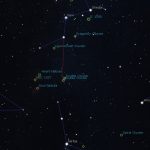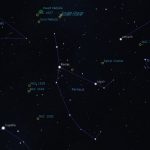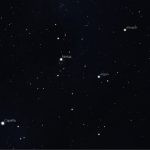| Meaning: | The Hero, the founder of Mycenae | Print out the star map from Sky and Telescope
Things to look for: Messier objects: Note: [x.x] indicates visual magnitude |
|
| Pronunciation: | pur’ see us | ||
| Associated Asterisms: | The Large Dipper | ||
| % of the sky: | 1.49% | ||
| Visible Stars: | 65 stars brighter than magnitude 5.5 |


Perseus is a circumpolar constellation from the UK and so is visible throughout the year. Although not deserving of a Messier designation, one of the most visited objects is the double cluster which sits in Perseus equidistant between Mirfak, α Per, and Ruchbah, δ Cas. It comprises NGC 869 and NGC 884. Perseus contributes to the Large Dipper asterism by providing the end of the handle with the Great Square of Pegasus providing the open end.
To find the constellation, follow the line of Andromeda from Alpharatz, α And, through Almach, γ And. This brings you to Mirfak, α Per. Mirfak is the brightest star in the constellation and Algol, β Per is the second. Algol was the first eclipsing binary every discovered; its variability has been observed visually for hundreds of years.


The constellation is named Perseus after the founder of Mycenae and the slayer of Medusa. Mirfak is his abdomen and Algol the head of Medusa in his left hand in this representation. η Per is the head and the curve of δ, ε and ζ are his left leg.
M34 is an Open cluster that can be found between Algol and Almach. M76 is a planetary nebula and approaching the farthest northern extent of the constellation near the star φ Per.

The Perseids meteor shower runs from 17th July to 24th August. The peak is on the 12th August and in good conditions you can expect a zenithal hourly rate of 60. The radiant moves between Cassiopeia and Perseus over the 5 weeks of activity as seen in the diagram. It is one of the most famous showers of the year because of the reliably high zenithal hourly rate, the warmer evenings, its longer duration and the brightness of some of the meteors. The dust causing the shower originate from comet Swift Tuttle.

